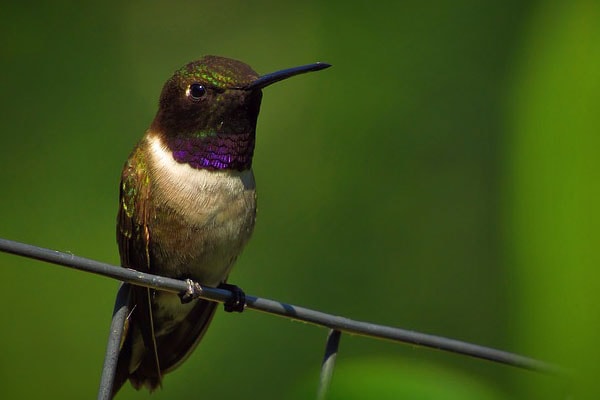Contents
- Black-chinned hummingbird facts
- How to identify a Black-chinned hummingbird
- Where You’ll see Black-chinned hummingbirds
- Diet and Feeding Preferences of Black-chinned hummingbirds
- Black-chinned hummingbird nesting
- Black-chinned hummingbird behavior
- Conservation Status of the Black-chinned hummingbird
- Fun & Interesting Facts about the Black-chinned hummingbird
- Explore More Species in This Family
The Black-chinned hummingbird is an unusually captivating species of hummingbird that makes its home throughout North America. Its appearance is distinctive and remarkable, and it has many unique behaviors. Birdwatchers and nature enthusiasts have been captivated by this diminutive creature for many years.
Its physical appearance is quite unique, to say the least. It measures roughly 3.5-4 inches or 9-10 cm in length. The adult males have a crown and back with metallic green colors that perfectly complement their beautiful black chin, which is obviously its namesake. Its throat is iridescent violet or purple, but it often looks black if you view it from different angles. Immature birds and females do not have a prominent black chin; instead, their throat is pale.
They make their home in the western part of the United States and northern Mexico while breeding and are known to travel long distances during the breeding season. On the other hand, during the winter months, they tend to live in southern Mexico and Central America while it’s still very cold outside in the North. Mainly, their migration patterns specifically depend on and are majorly influenced by blooming flowers and other available food sources.
While these hummingbirds aren’t necessarily considered or classified as endangered or threatened, it’s still important to pay close attention to pesticide use, climate change, and habitat loss because it could have a negative impact on their population. We must do our part to maintain a suitable habitat and provide excellent food sources to support these birds.
Today, I’m going to cover a wide range of important topics about the Black-chinned hummingbird. The topics include:
- Physical descriptions and other traits of the black-chinned Hummingbird
- The biggest differences between female and male black-chinned hummingbirds
- Dietary patterns, nesting preferences, feeding choices, and migration habits of Black-chinned hummingbirds
- Other valuable information about black-chinned hummingbirds
Are you ready to discover everything you ever wanted to know about Black-chinned hummingbirds? Continue reading until you reach the bottom of the page to learn the truth about these diminutive fast-moving birds.
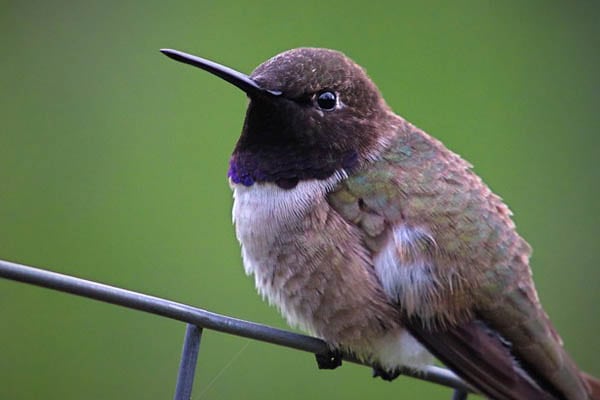
Black-chinned hummingbird facts
- Common Name: Black-Chinned Hummingbird
- Scientific Name: Archilochus alexandri
- Scientific Family: Trochilidae
- Life Span: 5-10 years
- Size: 3.5 to 4.0 inches
- Wingspan: 4.0 to 4.5 inches
- Weight: 0.10 to 0.15 oz
- Conservation status: Least Concern
How to identify a Black-chinned hummingbird
Figuring out the identity of a black-chinned hummingbird doesn’t need to be exceedingly difficult. You can do so by observing its behaviors and physical characteristics. It possesses key features to look for that include the following identifying markers:
- Size and Shape – the black-chinned Hummingbird is a really small bird with a compact body, and short wings when compared to the rest of its body, yet it’s very quick and agile during flight. Its body length measures 3.5-4 inches.
- Plumage – the black-chinned hummingbird adult male has a metallic green crown and back. Its throat, on the other hand, it’s iridescent purple or violet, yet it appears black when you view it from different angles. The chin, on the other hand, is covered with black feathers, which is the reason why it was given its name. The male also has a white belly and breast. Females and immature black-chinned hummingbirds do not have a black chin and they do possess a pale throat. All of their other colors and features remain the same.
- Behavior – then behavior this bird is very typical of other hummingbirds. It beats its wings very rapidly, which gives it the ability to hover in mid-air while feeding on nectar in its favorite flowers. This bird has incredible maneuverability and agility as well, which is awesome because it can fly upside down and backwards too.
- Vocalizations – it’s possible to identify black-chinned hummingbirds by their vocalizations, which also provide clues. Mainly, this bird is known for producing soft, high-pitched chirping or buzzing sounds. This happens particularly during flight or while defending their territory.
Difference between Male & Female Black-chinned hummingbirds
The major differences between males and females include their throat color and chin color. The adult males have vibrant iridescent violet or purple throats that often appear black. Females tended to have pale gray or whitish throats.
For their chin color, the males have black chins that really stand out amongst their metallic green crowns and back. On the other hand, immature birds and females do not possess a black chin. Their chin and throat is pale, and it extends all the way down to the breast.
Otherwise, they have very similar body sizes and shape, and the rest of their green plumage is basically the same. So, there are some differences, but not too many.
Differences in Summer Plumage vs Winter Plumage
The black-chinned hummingbirds do not experience any major significant changes to their plumage between winter and summer and vice versa. This isn’t necessarily true for other hummingbirds, but their plumage remains relatively consistent all year long.
At times, black-chinned hummingbirds might experience plumage variations due to fading over time. But these changes have absolutely nothing to do with the changes of the seasons.
Where You’ll see Black-chinned hummingbirds
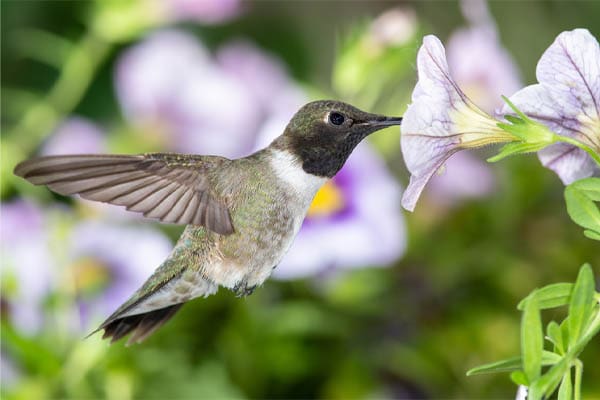
Black-chinned hummingbirds are mostly found in the southwestern and western parts of North America. Some of the most common areas where you’ll be able to spot black-chinned hummingbirds include:
- United States – these birds are found in several states in the US, including Arizona, California, Colorado, Idaho, Montana, Nevada, New Mexico, Oregon, Texas, Utah, and Washington. They are found most commonly in the southwestern and Western states.
- Mexico – these birds love making their way into northern Mexico during the breeding season. While visiting this country, these birds can be found in Baja California, Chihuahua, Durango, and Sonora.
If you’re looking to view black-chinned hummingbirds in the wild, you can find them in a wide range of diverse habitats. They prefer mountain meadows, scrublands, canyons, open woodlands, and gardens that attract hummingbirds. It’s fairly easy to attract hummingbirds to your backyard or local area as long as you have a plentiful supply of nectar-producing flowers. Keep them near water sources like rivers and streams, or better yet, install a birdbath and a hummingbird feeder in your backyard.
Black-chinned hummingbird migration patterns
During the winter, black-chinned hummingbirds go on far-reaching treks that take them incredibly long distances. They’ll travel all the way to southern Mexico and Central America. While here, the countries they tend to visit include Costa Rica, Guatemala, El Salvador, Honduras, and Nicaragua.
It’s difficult to pinpoint their exact migration routes because they do change. But more than likely, you’ll find black-chinned hummingbirds traveling along the Pacific coast or the Sierra Madre mountain ranges.
Diet and Feeding Preferences of Black-chinned hummingbirds
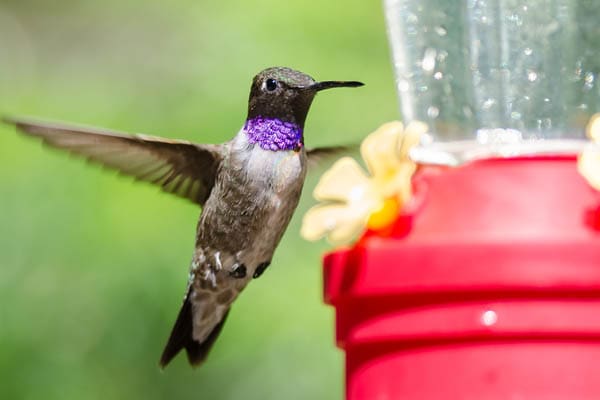
Like most other hummingbirds, it shouldn’t surprise anyone to learn that black-chinned hummingbirds love certain food sources, including nectar, small insects, and spiders. To break down more specifically, the particular details of the black-chinned Hummingbird diet and food preferences include the following:
- Nectar – these birds absolutely adored drinking nectar, and it is the main component of their overall diet. They get nectar from their favorite flowering plants, including flowering shrubs, garden flowers, and native wildflowers. They extract the nectar from deep within the flowers with their specialized tongue. In particular, black-chinned hummingbirds love brightly colored tubular flowers, but they really love red flowers the most, even though they visit a wide range of different flower types.
- Spiders and Insects – black-chinned hummingbirds may prefer nectar as their favorite food source, but they are certainly willing to supplement their diet and gain extra protein from spiders and other small insects. These little bugs pack a punch and deliver lots of protein and other nutrients to their diet. They catch them by hovering in midair and either snatch them out of the air or pull them off of leaves and branches.
- Hummingbird Feeders – like most hummingbirds, the black-chinned hummingbird isn’t afraid of humans. They would gladly drink nectar out of your birdfeeder as long as you fill it with a sugar-water solution. This is a great supplement to every hummingbird’s diet, but this is particularly true when natural nectar sources are becoming scarce.
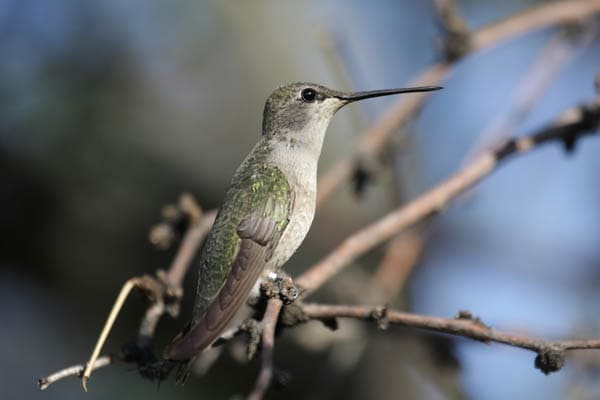
Black-chinned hummingbird nesting
- Clutch Size: 1-3 eggs
- # of Broods: 1-2 broods
- Incubation Period: 14-16 days
- Nestling period: 18-22 days
- Egg Description: White
This Hummingbird definitely has interesting nesting habits, to say the least. Right now, I’d like to focus on nest placement, nest structure, nest construction, a leg including size, incubation, and parental care, amongst other topics.
For starters, the black-chinned Hummingbird loves to build their nest near a water source, including a river or stream. They tend to do so on a horizontal tree or shrub branch. More often than not, it’s very difficult to find their nests because they build it in a spot with lots of concealment, which typically means it’s inside a thorny bush or dense foliage to provide added protection.
Like most Hummingbird nests, the structure is typically small and constructed in a cupped shape. The nest is typically built out of mosses, fine grasses, and plant fibers. The hummingbirds want to keep their nest protected and safe, so they will use materials like lichens to camouflage it so it better blends in with its surroundings.
Females are responsible for building and constructing the nest. Shall we together sticky plant substances and spider silk to make sure all those fibers and mosses and grasses stick together. She’s also responsible for collecting these materials as well. She then lines the inner cup with feathers, animal hair, or plant down to provide insulation and added comfort.
After completing the nest, the female will begin laying her eggs inside of it. More often than not, her clutch size will consist of two eggs. Occasionally, it will only be one egg, or even more rarely, it will consist of three eggs. Incubation is also the female’s job and it typically lasts 14-16 days.
Both parents are responsible for caring for their young after they are born. They each take turns feeding the nestlings by giving them small insects and nectar. The male’s job tends to gravitate toward providing food, while the female spends more time with her young.
During the nestling period, these young hummingbirds will stay with their parents for roughly 18-22 days as they grow quite rapidly and develop flight feathers. At this time, their parents will continue to feed them and provide protection until they fledge.
Black-chinned hummingbird behavior
Black-chinned hummingbirds exhibit unique behaviors. They include the following:
- Territorial Behavior – the males of the species do a great job of establishing their territories and defending them with gusto. They’ll choose territories that have access to potential mates and excellent nectar sources, of which they want exclusive access. They will perform aggressive displays, including aerial chases to keep other hummingbirds and different rivals from encroaching upon their territory.
- Courtship Displays – while the breeding season is underway, male black-chinned hummingbirds begin to perform their elaborate courtship displays in an effort to attract the females. Their displays include high-pissed vocalizations, flying in U-shaped patterns, or flying in arcs. In an effort to attract females, the males also love to display vibrant colors on their purple throats.
- Bathing – black-chinned hummingbirds love to bathe and keep their feathers clean so that they remain in optimal condition. They’ll visit nature-made or man-made water sources, including ministers, sprinklers, or puddles. They’ll gladly use any water source available to them as long as they can bathe in it.
- Perching and Resting – these birds are incredibly active flyers, yet they’ll also spend part of their day perching and resting. Typically, they will perch on utility wires or exposed branches because it gives them an excellent vantage point that they can easily monitor their territory from.
Conservation Status of the Black-chinned hummingbird
The black-chinned hummingbird’s conservation status is known as Least Concern. As the name suggests, these birds aren’t considered to be facing any immediate threat of extinction. Their population is considered stable at the moment.
It’s important for concerned citizens to keep a close eye on these birds to make sure their conservation status remains stable. Some potential threats to this population include habitat loss, climate change, pesticide use, and competition and predation.
Fun & Interesting Facts about the Black-chinned hummingbird
Check out some interesting facts about the Black-chinned hummingbird below:
- Black-chinned hummingbirds have a high metabolism. They burn calories at an alarming rate because they’ll flap their wings as many as 80 times per second in the midst of normal flight. During courtship dives, they flap their wings as many as 200 times per second, which certainly burns a tremendous number of calories.
- Black-chinned hummingbirds are migratory marvels. Even though they are incredibly small, they will fly for impressive distances during their migration season’s. While moving from their breeding ground to their winter grounds, they will travel from the western United States and go as far as Central America.
- These hummingbirds are masters at conserving energy. On cool nights or times when food is scarce, these hummingbirds have the ability to enter a state of torpor. This state slows down their metabolic rate to a significant level, it drops their body temperature, and makes it possible to conserve energy to survive while there are few fuel sources available.
- The males of the species are very aggressive, territorial, and they are willing to defend their territory. They will implement aggressive displays and engage in aerial chases to keep intruders at bay. This includes certain large birds and other Hummingbird species.
- Black-chinned hummingbirds are considered pollinators and possess an important ecological role. As they feed on nectar, they wind up transferring pollen from flower to flower, which contributes to biodiversity while aiding in plant reproduction.
Explore More Species in This Family
- Long-billed Hermit (Phaethornis longirostris)
- Red-billed Streamertail (Trochilus polytmus)
- Crowned Woodnymph (Thalurania colombica)
- Violet Sabrewing (Campylopterus hemileucurus)
- Ruby-topaz Hummingbird (Chrysolampis mosquitus)
- Allen’s Hummingbird (Selasphorus sasin)
- Amethyst Woodstar (Calliphlox amethystina)
- White-bellied Woodstar (Chaetocercus mulsant)
- Snowcap (Microchera albocoronata)
- Blue-throated Hummingbird (Lampornis clemenciae)
- Sparkling Violetear (Colibri coruscans)
- Black-throated Mango (Anthracothorax nigricollis)
- Xantus’s Hummingbird (Hylocharis xantusii)
- Long-tailed Hummingbird (Rhamphomicron longicauda)
- Berylline Hummingbird (Amazilia beryllina)
- Broad-tailed Hummingbird (Selasphorus platycercus)
- Green-breasted Mango (Anthracothorax prevostii)
- Brazilian Ruby (Clytolaema rubricauda)
- Ecuadorian Hillstar (Oreotrochilus chimborazo)
- Magnificent Hummingbird (Eugenes fulgens)
- Green Thorntail (Discosura conversii)
- Ruby-throated Hummingbird (Archilochus colubris)
- White-tailed Goldenthroat (Polytmus guainumbi)
- Black-crested Coquette (Lophornis helenae)
- Buff-bellied Hummingbird (Amazilia yucatanensis)
- Anna’s Hummingbird (Calypte anna)
- Cinnamon Hummingbird (Amazilia rutila)
- Bronze-tailed Plumeleteer (Chalybura urochrysia)
- Rufous Hummingbird (Selasphorus rufus)
- Gorgeted Woodstar (Chaetocercus heliodor)
- White-necked Jacobin (Florisuga mellivora)
- Long-tailed Sylph (Aglaiocercus kingii)
- Black-breasted Puffleg (Eriocnemis nigrivestis)
- Shining Sunbeam (Aglaeactis cupripennis)
- White-vented Plumeleteer (Chalybura buffonii)
- Calliope Hummingbird (Selasphorus calliope)
- Fiery-throated Hummingbird (Panterpe insignis)
- Violet-headed Hummingbird (Klais guimeti)
- Little Woodstar (Chaetocercus bombus)
- Purple-crowned Fairy (Heliothryx barroti)
- Booted Racket-tail (Ocreatus underwoodii)
- Violet-crowned Hummingbird (Amazilia violiceps)
- Costa’s Hummingbird (Calypte costae)
- Plain-capped Starthroat (Heliomaster constantii)

